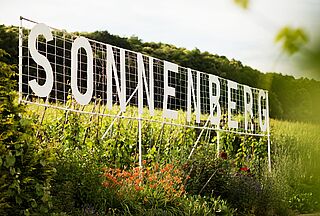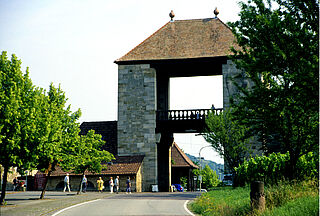Sonnenberg
Kendte vinmarker
Schweigener Sonnenberg
International Gateway to Pinots, Riesling, Silvaner & Gewürztraminer
Bockenheim and Schweigen-Rechtenbach are at opposite ends of the Deutsche Weinstrasse (German Wine Road), the 80-km/50-mile, north-south route that winds through the Pfalz wine-growing region. Not only does each town boast a massive Weintor, or gateway, marking the start/finish of the wine road, but each also has a vineyard named Sonnenberg a popular appellation for sloping (Berg) sites in the sunny (Sonne) Pfalz, where no fewer than eight sites bear this name.
This month’s famous site is the southernmost of the Pfälzer “Sonnenberg” sites, and quiteunique in that it extends a few kilometers/couple of miles beyond the German border to Wissembourg in Alsace. Many a wine-growing family in Schweigen-Rechtenbach has cultivated vines in this “border zone” for generations. German growers with holdings between Schweigen-Rechtenbach and Wissembourg are permitted to market the wines produced from their “French” grapes under the German appellation Sonnenberg. Although this practice does not conform with EU regulations concerning the origin of quality wines produced in a specified region (e.g. German QbA and QmP wines), it is an exception sanctioned by the German wine law. Nearly all the French wine-growers in and around Wissembourg deliver their crop to the cooperative winery in Cleebourg.
With the wine law of 1971, many small sites and parcels in Schweigen-Rechtenbach, Oberotterbach and Schweighofen were consolidated and renamed Sonnenberg, thereby creating quite a large individual site (300 ha/750 acres in Germany and ca. 150 ha/375 acres in France). The soils consist of lime-rich marl, loam and loess, as well as weathered sandstone and mixtures of sand with loam and/or loess. In general, they are deep, retain water well, and heat up quickly. About 2/3 of the site is fairly flat to gently sloping; 1/3 is steep. The site is planted primarily with white and red Pinots (Grauburgunder/Ruländer/Pinot Gris; Weissburgunder/Pinot Blanc; Auxerrois; Chardonnay; and Spätburgunder/Pinot Noir) and the traditional white varietals Riesling, Silvaner and Gewürztraminer.
A Quick Look at the Past...
Vines have been cultivated in the southern Pfalz/northern Alsace at least since Roman times. Viticulture declined in the aftermath of invasions by the Alemanni, a group of Germanic tribes. In The Wines of Alsace, British wine writer Tom Stevenson credits Clovis, King of the Franks, as being the 'indirect’ catalyst of the region’s viticultural revival. In a battle near Wissembourg in AD 496, he defeated the Alemanni and forced them to move east of the Rhine. In the same year, Clovis was baptized and henceforth, fostered the spread Christianity in his kingdom. This gave rise to the establishment of dozens of monasteries in the region. They became major vineyard owners and wine was an important source of income. The earliest documented mentions of many villages and vineyards in the southern Pfalz/northern Alsace, for example, are in 8th-century deeds of gift to the Benedictine abbey in Wissembourg.
...and the Future
Until the 1980s, the Südliche Weinstrasse (Southern Wine Road, from Neustadt to the French border) was often associated with quantity rather than quality, and the majority of wines were sold in cask – as anonymous components destined for mass-produced, commercial blends and/or inexpensive varietals. Slowly but surely, exceptional growers and their estate-bottled wines developed a profile, overall quality standards improved at estates and cooperative wineries, and modern marketing strategies helped reposition the region’s image. It was in this spirit that five like-minded friends decided in 1990 to pool their viticultural savvy and collectively market their wines as Fünf Freunde aus der Südpfalz (www.fuenf-winzer.de). They captured the attention of the trade and the press at home and abroad, and thus helped put the Südpfalz on the map for serious wine lovers.
Sonnenberg Superlatives
The original (pre-1971) Sonnenberg site is a south-facing hillside behind Schweigen proper, adjacent to the French border. It is in this select portion of today’s (much larger) Sonnenberg site that Friedrich Becker – one of the “five friends” and named “shooting star of 2006” by the German wine guide Gault Millau – cultivates 30-year-old Riesling vines. The lime-rich marl yields smooth, full-bodied Rieslngs with a moderate acidity.
Becker is especially well-known for fine Spätburgunders, the best of which are from the Kammerberg, a tiny, steep parcel situated across the border. Thanks to the soil structure – a pure layer of limestone underlies a mixture of lime-rich marl and clay – and excellent southern exposure, Kammerberg Pinots are very ripe, with firm tannins and great longevity. Even centuries ago, the monks in Wissembourg recognized the potential of the site, for it consistently yielded outstanding wines. They came to be known as Kammerweine, since they were stored in a special Kammer, or chamber, reserved for the abbot’s finest wines.
Tips for Tourists
Schweigen
- Germany’s oldest (1969) Weinlehrpfad, an educational wine path signposted with viticultural information, including a demonstration plot showing Kammertbau, the method used by the Romans to support/train vines. Tasting stand is open May to October.
- Deutsches Weintor (1936), German Wine Gateway that marks the start/finish of Germany’s first wine route (1935), Deutsche Weinstrasse. The observation platform affords an excellent view of the Sonnenberg site that straddles the Franco-German border. A restaurant and aVinothek (wine shop) are on the premises.
- Weinstube at Weingut Jülg not only serves the estate’s wines, but also homemade cheese, sausage and ham. Closed Thursday, Friday and from mid-December to February. No credit cards.
Wissembourg (4 km/2.5 miles south of Schweigen)
- Restaurant Au Cygne, 3 Rue du Sel, serves wines from the “five friends.”
Landau (21 km/13 miles northeast of Schweigen)
- Restaurant Fünf Bäuerlein (Five LIttle Farmers), Theaterstrasse 2,
- is owned by and serves wines from the “five friends.” Closed Saturday evening through Monday lunch. No credit cards.
- Weintage der Südlichen Weinstrasse, 16–19 June 2006, Frank Loebschen Haus, is an annual, comprehensive presentation of more than 500 wine and sparkling wines by 80 Southern Weinstrasse wine-growers.
Many thanks to Frau Renate Scheib, wine & tourist information about the Südliche Weinstrasse, An der Kreuzmühle 2, Landau (www.suedlicheweinstrasse.de), and in Schweigen: Frau Wegmann, Herr Jülg/Weingut Jülg, and Herr Becker, Jr./Weingut Friedrich Becker.


